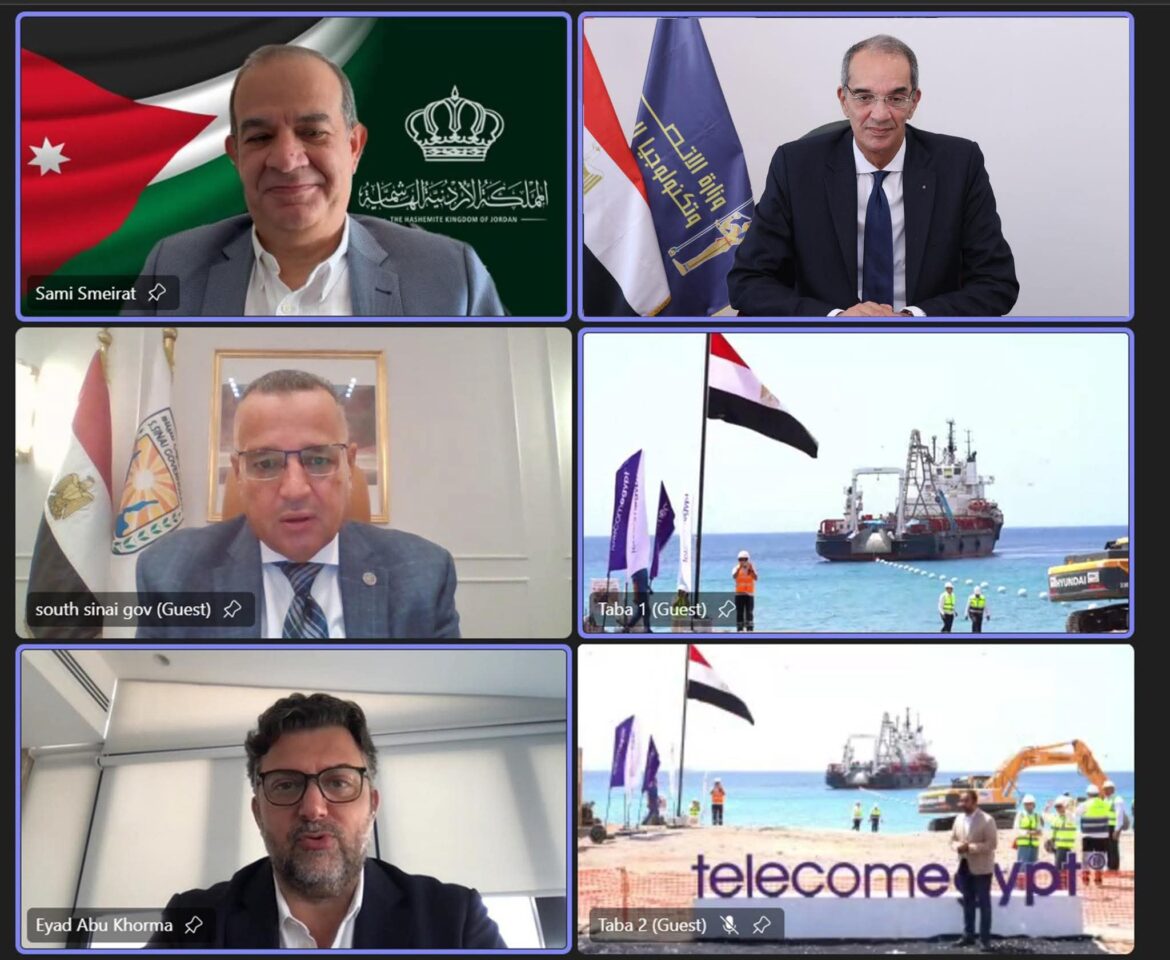The Minister of Communications and Information Technology Amr Talaat, the Jordanian Minister of Digital Economy and Entrepreneurship Sami Smeirat, and the Governor of South Sinai Khaled Mubarak have witnessed, via videoconference, the landing of Coral Bridge—a high-capacity subsea cable—in Taba City. This milestone comes within the framework of the Ministry of Communications and Information Technology’s (MCIT) strategy to expand and strengthen Egypt’s global information infrastructure.
The landing was witnessed, via videoconference, by the Managing Director and CEO of Telecom Egypt Mohamed Nasr and the Founder and CEO of Aqaba Digital Hub (ADH) Eyad Abu Khorma.
Coral Bridge is the first direct subsea cable linking Egypt and Jordan in more than 25 years. It delivers a high-speed, direct digital connection supported by a large number of optical fibers, crossing the Gulf of Aqaba. The cable marks a pivotal step in advancing digital infrastructure across the Middle East.
The cable is the first telecom system to be landed at the Taba landing station, part of the digital infrastructure recently established by Telecom Egypt in the Sinai Peninsula. The cable is scheduled to be landed in Aqaba within the coming days at ADH’s global data center, ensuring service continuity by providing alternative routes and backup connections, supporting the plans of major companies and cloud service providers hosted at the data center to safeguard their operations.
Coral Bridge offers seamless connectivity across three continents: Asia, Africa, and Europe—capitalizing on the strategic location of the two countries and Telecom Egypt’s extensive subsea cable infrastructure. This creates broader opportunities and benefits for businesses locally, regionally, and internationally.
The 15-kilometer subsea cable has been designed with a large number of optical fiber, enabling the aggregation and transmission of high-capacity international data traffic to meet the surging demand driven by Artificial Intelligence (AI) applications and data centers. Moreover, its short length boosts international data transfer speeds while reducing costs.
In his remarks, the ICT Minister emphasized that Coral Bridge is a valuable addition to the Arab subsea cable network. He highlighted its role in reinforcing ICT cooperation between Egypt and Jordan. Talaat explained that it is the first subsea cable system to be landed in Sinai as part of wider efforts to diversify international infrastructure by establishing new landing points and terrestrial routes for subsea cables linking the Red Sea and the Mediterranean.
The ICT Minister underscored that a plan is underway to expand the subsea cable network in the Sinai Peninsula, providing closer access points for neighboring countries. This, he added, will enhance regional connectivity while boosting the efficiency and speed of international data transmission.
Furthermore, Talaat pointed to MCIT’s commitment to reinforcing Egypt’s competitiveness as a primary hub for international data traffic between East and West. He noted that more than 90% of data traffic between the two regions passes through Egypt via an extensive network of 15 subsea cables. He added that the country currently has approximately 11 landing points.
For his part, Smeirat underlined the historical ties between Egypt and Jordan. He stated that the implementation of the Coral Bridge project is a tangible outcome of the bilateral cooperation established under the guidance of the two nations’ political leadership. He highlighted that the project serves as a practical embodiment of this cooperation within the ICT sector, particularly as it follows the 33rd Session of the Egypt–Jordan Joint Higher Committee, held just days earlier in Amman, Jordan.
Smeirat also pointed out that this cable represents a new digital gateway for Jordan. He stressed the ongoing efforts to expand such digital gateways, positioning Egypt and Jordan as regional and even global hubs for data transmission.
Moreover, the Jordanian Minister said he looked forward for more joint projects between the two countries in the near future. He also extended an invitation to the ICT Minister to visit Jordan to hold additional discussions aimed at deepening bilateral ICT cooperation.
Mubarak, for his part, underlined the strong ties between Egypt and Jordan. He noted the ongoing collaboration between the South Sinai Governorate and Aqaba City in implementing various tourism and sports projects.
Mubarak also expressed his pleasure at the landing of the Coral Bridge subsea cable in Taba. He stressed its importance in enhancing digital connectivity with Jordan and providing digital communication that contributes to strengthening bilateral cooperation and fostering scientifically based integration. He also emphasized the vital role of the Internet in promoting tourism in South Sinai.
It is worth noting that Coral Bridge was designed following the highest technical and environmental standards. It was developed with sustainability at its core, ensuring a balance between capacity, performance, and environmental responsibility.
The project was implemented under the January 2024 cooperation agreement between Telecom Egypt, the first integrated telecom operator in Egypt and one of the largest subsea cable operators in the region, and NaiTel, a licensed telecommunications service provider in Jordan and the telecom arm of ADH. This reflects the significance of cross-border partnerships, which open new avenues for growth, deliver sustainable benefits for all stakeholders, and pave the way for more infrastructure projects serving the Middle East and other regions worldwide.


